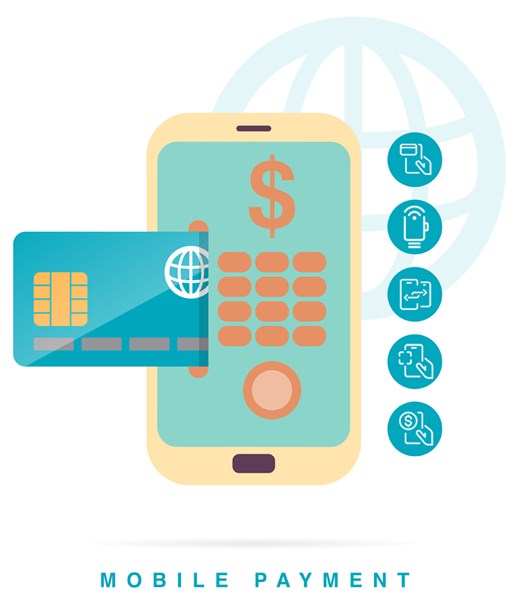As mobile technology continues to grow and change, so does consumer appetite for embracing it. According to the Pew Research Center, 67% of Americans own a smartphone and 19% use their smartphones to stay digitally connected to the world. People use their smartphones regularly to check the news, post social media updates, connect with friends and family, email colleagues or make mobile payments. As the most technologically-connected generation of modern time, it’s no surprise that millennials are leading the mobile payment revolution, with 75% of them using their mobile phones for mobile banking. The U.S. Census Bureau estimates this generation makes up more than 75 million people, which means there are about 56 million mobile phones using mobile banking services on a regular basis.

In addition, eMarketer expects that by 2020, 90% of smartphone users will have made a mobile payment, and the total value of mobile payment transactions in the United States (average user spent $376 in 2015) will grow 210% this year.
The growth in mobile phone use is fueling the growth in mobile payments, which in turn is fueling the growth of mobile payment providers and services. To stay relevant to cardmembers, credit unions need to be knowledgeable about the different types of payment methods available to their members in order to keep up with banking trends and membership needs. This paper is a guide for credit unions to embrace the world of mobile payments.
What Exactly Are Mobile Payments?
Mobile payments are payment services that operate under the normal financial regulations but are performed via a portable electronic device such as a tablet or smartphone. The table below explains the five main types of mobile payments along with potential pros and cons for each method.
TYPE OF MOBILE PAYMENT |
||||
MOBILE AT THE POINT OF SALE (POS) |
MOBILE AS THE POINT OF SALE (POS) |
MOBILE PAYMENT PLATFORM |
DIRECT MOBILE BILLING
|
CLOSED LOOP MOBILE PAYMENTS |
| Known as the mobile wallet, the cardmember’s credit card is stored as a unique token in his/her smartphone. This system allows cardmembers to pay for goods and services at a store with a mobile device using Near Field Communication (NFC) or Magnetic Stripe Transfer (MST), which involves placing their devices at the register, aka Place and Go method. | The merchant, not the cardmember, uses a mobile device to process credit card payments. The mobile device or smartphone basically becomes a cash register. | Today, cardmembers can transfer funds to each other or even to merchants via many peer-to-peer payment platforms.This type of mobile payment is considered the everything else category as the platform does not act like a mobile wallet nor involves using a mobile device as a cash register. | Charges are placed on the smartphone bill via in-app billing or through text messages via SMS. In many cases, the phone company acts as the billing agent for the third-party app content creators. In-app billing is available as well, which will hit the credit card just like a store credit. | This mobile payment resembles a mobile version of private label payment. The retailer creates its own digital wallet and mobile payment platform system. Cardmembers then place funds or other payment sources into the app and use it when making future purchases. Cardmembers typically load the app with many sources including credit, cash, and debit. Cardmembers can also store coupons and gift cards and track loyalty rewards on the closed-loop system. |
| PROS: Overall convenience and ease of given mobile nature with no need for members to carry their physical wallets around. | ||||
| The majority of new smartphones are now NFC-equipped.
More secure than swiping a credit card through a reader as there are security measures, such as biometric finger readers or a PIN code to approve the purchase. The token is tied to the device so that it cannot be used through another method. Mobile wallets can offer location-based services, such as in-store interactions or alerting cardmembers to an offer in a nearby store. Some mobile wallets allow cardmembers to store tickets and boarding passes electronically on their mobile devices instead of using paper copies. |
A digital cash register is a big plus given that physical cash registers and credit card processing terminals can be expensive, especially for smaller businesses (like a food truck).
Allows for greater mobility when a small business owner wants to take card payments. Some mobile-at-the-POS solutions will aggregate all card costs and fees (the card company, bank, and the processor) into one single charge. Merchants do not have to worry about paying separate fees to multiple parties. |
This method represents an alternative to traditional payments and provides an alternative to cash and credit/debit payment, allowing a cardmember to transfer money directly to another person. | Charges are placed directly on the phone bill and payment collected via a pre-determined process with a cardmember.
Cardmembers with older phones have SMS technology built in so he/she can make purchases without an actual smartphone. The mobile service provider manages the billing, so cardmembers do not need an additional separate monthly bill to oversee. Personal information is never given to a third-party as credit card and bank information are stored with the mobile solution provider. |
Credit card or bank information does not get transferred to the merchant at the point of purchase.
In-store incentives can be built into the app eliminating the need to clip paper coupons. |
| CONS: Perceptions around security and privacy remain an issue for mobile payments as beliefs persist that using a mobile device for payment brings increased complexity and increased security risks versus using a physical credit card. Overall, cardmembers remain uncertain about how mobile payments compare with other payment methods in terms of cost, convenience, privacy, and security. Another issue is merchant adoption. Cardmembers are willing to use mobile payments extensively at their favorite grocery store but are not clear about which merchants accept it as a form of payment. | ||||
| Cardmembers are unsure where they can use their mobile wallet due to merchant adoption issues or lack of information about acceptance. | Processing fees might not be competitive with fees charged by traditional processors. Fees by the provider often run into the 3% range.
Not all mobile-at-the-POS solutions allow for acceptance of payments from mobile wallets. Some businesses may have irregular transactions that can trigger a red flag with the mobile payment’s fraud detection system, which could delay payments from reaching the merchant’s bank account. |
Credit card or bank fees still apply, though may be minimized with integration via ACH into DDA systems.
Limited, but growing, acceptance at retailers. |
SMS has been known to be slow in speed and unreliable. High usage can entail a costly fee.
Limited number of parties willing to accept payment in this manner. |
Store-created digital applications continue to face competition from other mobile payment types.
Some cardmembers view pre-funding money to the mobile payment platform as a hassle or a financial infeasibility. The desire to have multiple payment apps appears to be low. |
| EXAMPLES | ||||
| MasterCard, Visa, Apple Pay, Android Pay and Samsung Pay, Microsoft Wallet. Samsung has NFC and MST. Samsung phones can be used at 90% of the terminals currently in the market. Apple and Android must be used at terminals that are NFC-enabled. | Square and VeriFone. At Nordstrom and Nike, their floor sales people all carry phones to check customers out. | Venmo, Zelle, PayPal, and Uber. | Any in-app payment. Ringtones historically or more recently games like Pokemon GO. For example, when someone texts #flood to the Red Cross to donate $10, that $10 hits the donor’s mobile bill and not his or her credit card statement. | Starbucks and Walmart Pay. |
Conclusion
Consumer demand for simpler, mobile payments has created a marketplace with numerous different solutions. With the many mobile digital solutions in the market today, they all are struggling to gain traction on the critical mass, due to multiple issues. Solution providers have been challenged with the transition from one space into another such as peer-to-peer to mass commerce acceptance. Many consumers lack the bandwidth to utilize multiple mobile payment solutions at the same time, choosing to revert back to established patterns. Finally an increasing number of retailers are choosing to offer a mobile payment solution, creating a more fractured landscape.
Overall, cardmembers are engaged around mobile payment solutions though the final landing spot remains uncertain. Mobile payments technology is still early in the adoption stageand there will come a time when the gap between awareness and adoption merge. In the interim, credit unions and other financial institutions should remain flexible in providing as many solutions to their cardmembers as reasonably possible, while watching the industry for future solutions. Credit unions need to make multiple bets in this environment.
Click here to download a copy of the white paper, Embracing the Rewards and Risks of Mobile Payments.
Elan is the leading credit card provider in the industry that offers partners a suite of credit card products that competes with the national issuers, technology solutions that cater to audiences across the credit spectrum, and free access to a marketing engine to help generate new accounts. By partnering with Elan, credit unions can offer cardmembers valuable mobile payment options such as Apple Pay, Android Pay, Samsung Pay, and Microsoft Wallet. For over 45 years, Elan has delivered exceptional credit card products and service to more than 300 credit unions. For more information, call 1-800-223-7009 or visit https://www.cupartnership.com.

